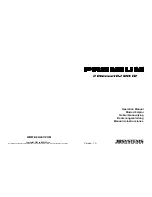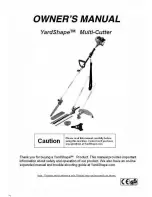
© 2014 CPT Autopilot Inc.
www.cptautopilot.com
Page 6 of 17
F. Rudder Control
The Rudder control turns the autopilot on, and determines how far the boat’s wheel & rudder turn when a
heading correction is needed. Low settings result in smaller wheel corrections, higher settings in larger wheel
corrections. The corrections are proportional to the amount of heading change needed. The best rudder setting
will be high enough to return the vessel to heading with just one or two motor pulses or corrections. If the pilot
responds with many smaller repeated corrections in one direction, raise the rudder setting.
The CPT rudder control performs like a helmsman in a fog who can only see the compass. If this helmsman is
told to move the wheel exactly one inch for each five° heading error, he will do exactly that every time a
correction is needed. If these motions result in under-control and sluggish corrections, you can tell him to move
the wheel further for a given correction.
The rudder control is used to match the CPT’s response to your boat's steering needs. Some boats take many
turns of the wheel to move the rudder, while others take only a few. The rudder control can adjust for this. Every
boat also responds somewhat differently to the rudder. Generally full keel boats with more turns lock-to-lock
take a higher rudder setting, but this rule does not always follow for some spade-rudder boats.
If the rudder control is set too high for your boat, the wheel will turn too far; the boat will over-steer too far port
& starboard. Lower the rudder setting.
The most common mistake seems to be setting the rudder setting too low. If the rudder control is set too low, it
will make many small repeated corrections in one direction to return to the desired heading, and will spend a lot
of time on one or both sides of the rhumb line. Too low of a rudder setting and the boat will gradually fall off and
the pilot will not keep the boat on heading. .Almost all boats require a rudder setting of 4 or higher.
Either of these actions is relatively easy to identify and, with some experimentation underway, you should be
able to find the correct setting for your boat. A rudder setting that works while sailing in lighter winds may have
to be raised when winds increase.
The best rudder setting will be set high enough to return the vessel to
heading with just one or two pulses or corrections.
A boat may require a slightly higher rudder setting at low speeds than at higher speeds. A sailboat may require a
higher setting when running than when beating and a higher setting when sailing than when motoring.
Full Keel Boats: A full keel boat with 3-4 turns lock-to-lock will typically use a rudder setting of 5-6.
Fin Keels & Spade Rudders: Response to the wheel may be more sensitive. The rudder setting will depend on
the boat’s response to the rudder, and you will need to see what setting works best. It may take more balancing &
de-tuning for steady steering & keeping the boat from reacting to every gust or condition. With increased speed
downwind, response to the rudder increases, and lowering the rudder setting slightly works well. If the boat is
easily understeered or oversteered, the rudder setting may be a compromise between the two.
If you are becalmed, stuck in irons or not making headway, disengage the CPT. The CPT will continue to try and
make heading corrections, but the vessel will not respond to rudder changes. If left unattended the rudder could
eventually hit the rudder stops.
(Avoid hitting the rudder stops; if it occurs a looser belt provides some give and you will hear a warning thump
as the belt jumps in its cogs; but if the belt is over-tensioned or used with a tensioner it eliminates any give in the
system, and the shear pins are designed to shear)
G. Deadband Control
The deadband dial determines how far the vessel can stray from heading before a correction is made (dead
range). In a proportional pilot, there is always some deadband inside which the pilot does not activate. If
this deadband is small, (1°-2°) the pilot will continuously run port or starboard making course corrections.
In a seaway, a boat will yaw back and forth along the desired course as it makes its way over the waves, but
generally it has enough directional stability to keep a fairly good average heading. An adjustable deadband
permits the boat to work its way through the waves without continuously using the rudder to try to fight the
natural weaving and movement of the hull.
The deadband setting is adjusted with the deadband dial. When first using the CPT start out with the deadband
set to minimum.. Turning the dial clockwise increases the deadband. Most boats steer nicely at settings of 2-3 in
swells, with lower settings in flat water. On long passages, turning the deadband and rudder up a bit higher can




































